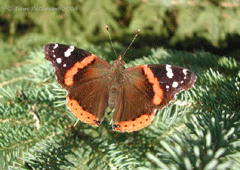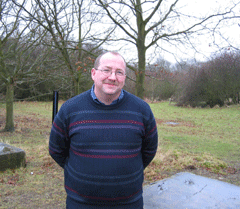British Invasion
Air Date: Week of March 23, 2007

The Red Admiral (Vanessa atalanta) (Photo: (c) Tom Peterson 2004)
Warming temperatures in northern Europe are luring some southern species of insects across the English Channel for the first time in recorded history. Scientist Tim Sparks speaks with Living on Earth's Bruce Gellerman about the butterfly invasion of Britain.
Transcript
GELLERMAN: It’s Living on Earth. I’m Bruce Gellerman. Butterflies are beautiful and soon they’ll be fluttering back into many fields and gardens, a welcome sign of spring. But in Great Britain, it seems, some butterflies and moths are wearing out their welcome.
Joining me on the line is Dr. Tim Sparks. He’s an environmental scientist with the Center for Ecology and Hydrology in Cambridgeshire, England. Welcome to Living on Earth Dr. Sparks.
SPARKS: Hello, thank you.
GELLERMAN: So, I understand that from reading your article in the European Journal of Entomology that the number of species of butterflies and moths has increased to Britain four fold in the last 25 years. Sounds like a good thing to me.
SPARKS: Well, I mean, it’s certainly good for biodiversity, in that sense. And um where as 25 years ago we regularly got 10 species arriving each year, um we’re now getting more like 40. And there are good things and bad things of course. We appreciate the butterflies when they come in but we’re not necessarily so keen on some of the moth species, which may be pests as well.

Tim Sparks (Courtesy of Tim Sparks)
SPARKS: Well, it’s very clear that this is all to do with warmer temperatures further south in Europe. So in summer when it’s warm we get this northwards movement of butterflies and moths and they cross the English Channel and they turn up on the south coast. And in many cases we’re seeing species for the first time.
GELLERMAN: So when these new species come to Great Britain are they taking over the habitats of you know the indigenous species?
SPARKS: Well, that’s something we don’t know too much about and it does cause us concern. We don’t know exactly what the competition will be. We do know with introduced species that they can cause huge problems for native species by out-competing them. And we’ve got lots of examples in this country of that happening.
GELLERMAN: Well, we all know about the destruction caused by the gypsy moths. Are you seeing any destruction from any of these butterflies or moths that are coming in?
SPARKS: We’re not seeing that yet. I mean there is always concern that some of these moths are pests of agriculture, um and they would include the family which are known as Tineidae moths which attack root crops. Um we don’t have any evidence yet of big economic problems but that doesn’t say that we won’t get that in the future.
GELLERMAN: Well, butterflies and moths are of course insects. Are you seeing other insects then invade?
SPARKS: We are we’re seeing new dragonflies, we’re seeing new crickets, we’re seeing new bees, we’re seeing new flies. All the evidence is pointing towards a much greater number of species um, starting to turn up in this country. And we believe that it’s happening in many other species groups as well which are currently not very well recorded. We’re very lucky that people are keen to record moths and butterflies and dragonflies and butterflies but there are some very obscure insect groups out there that don’t have many fans and don’t have many people recording them.
GELLERMAN: So, Dr. Sparks has Southern Europe seen new insects coming up from further south than they are?
SPARKS: Yes, certainly I mean, there’s been a shift both towards the poles and up mountain sides as well. So, we’ve seen species that are getting, um, further up mountains than they used to be, um, and we’ve also seen some new species in Southern Europe. We know more perhaps about Gibraltar and um. They now have their own population of monarch butterflies. Interestingly in Gibraltar it’s not migratory so it’s a resident species in Gibraltar before is was present on the Canary Islands out in the Atlantic and it now seems to have become resident in Gibraltar.
GELLERMAN: Dr. Sparks, I understand that you model your data on a computer. Um what does that model look like?
SPARKS: Well, the sorts of models that I use are statistical models. Where we’re actually looking at changes and we’re trying to relate those changes to temperature effectively. And what we’d ultimately be liking to do is predict in the future by how much things will change as the temperature will continue to increase.
GELLERMAN: Are you at your computer now?
SPARKS: I am.
GELLERMAN: Ah, can you pull up a model for me?
SPARKS: Ok, for instance I can look at my computer at the moment and I’m currently working on two bird species: Sand Martin and Swallow. And I can clearly see that the Sand Martin which used to arrive at the beginning of April, 50 years ago is now arriving about 20 days earlier than that. And that’s a big change over a relatively short time span.
GELLERMAN: That’s going to really change the ecology of well, Great Britain if not the rest of Europe.

The Red Admiral (Vanessa atalanta) (Photo: (c) Tom Peterson 2004)
SPARKS: Yes, I mean we’ve already seen a few examples of species that have been migratory starting to settle. Two classic examples in birds are the Chiffchaff and the Black Cap, both warblers which are now present in large numbers in Britain during the winter. But we’ve also seen a few migratory butterflies, the Red Admiral and the Clouded Yellow which traditionally, um, haven’t survived a winter in this country are now being able to do so. So they’re present in the country all year round.
GELLERMAN: These butterflies and moths have some great names. You mentioned Clouded Yellow, Red Admirals.
SPARKS: Yup.
GELLERMAN: The Hoary Footman?
SPARKS: (laughs) Well the Hoary Footman’s a moth. Yeah, there are big changes going on now, very big changes and we’ve only had really modest climate warming so far, about a degree. You know there’s a lot more that’s going to happen in the future.
GELLERMAN: Dr. Tim Sparks is an environmental scientist at the Center for Ecology and Hydrology in Monks Wood, Cambridgeshire Britain. Dr. Sparks thank you very much.
SPARKS: My pleasure thank you.
Links
Living on Earth wants to hear from you!
Living on Earth
62 Calef Highway, Suite 212
Lee, NH 03861
Telephone: 617-287-4121
E-mail: comments@loe.org
Newsletter [Click here]
Donate to Living on Earth!
Living on Earth is an independent media program and relies entirely on contributions from listeners and institutions supporting public service. Please donate now to preserve an independent environmental voice.
NewsletterLiving on Earth offers a weekly delivery of the show's rundown to your mailbox. Sign up for our newsletter today!
 Sailors For The Sea: Be the change you want to sea.
Sailors For The Sea: Be the change you want to sea.
 Creating positive outcomes for future generations.
Creating positive outcomes for future generations.
 Innovating to make the world a better, more sustainable place to live. Listen to the race to 9 billion
Innovating to make the world a better, more sustainable place to live. Listen to the race to 9 billion
 The Grantham Foundation for the Protection of the Environment: Committed to protecting and improving the health of the global environment.
The Grantham Foundation for the Protection of the Environment: Committed to protecting and improving the health of the global environment.
 Contribute to Living on Earth and receive, as our gift to you, an archival print of one of Mark Seth Lender's extraordinary wildlife photographs. Follow the link to see Mark's current collection of photographs.
Contribute to Living on Earth and receive, as our gift to you, an archival print of one of Mark Seth Lender's extraordinary wildlife photographs. Follow the link to see Mark's current collection of photographs.
 Buy a signed copy of Mark Seth Lender's book Smeagull the Seagull & support Living on Earth
Buy a signed copy of Mark Seth Lender's book Smeagull the Seagull & support Living on Earth

